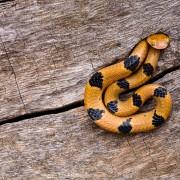Thin like a (small) snake
During my last trips to Peru, Borneo and South Africa I had the chance to witness some nice examples of convergent evolution. This is the case of three different species of snake, that share the same nocturnal arboreal habits although they normally prey on different species.
The Peruvian species is the beautiful and somewhat famous blunthead tree snake Imantodes cenchoa, a very common species in the pedemontane and lowland Amazon forests. It normally preys upon frogs and their eggs and it’s able to see very well thanks to its giant bulging eyes, adapted for night vision. The body is something particular, a sort of thin, compressed “string”, packed with strong muscles to help this forest imp to climb every sort of twig or branch in search of its preys.
The Bornean species is the secretive, tiny Blunthead Slug Snake Aplopeltura boa, another “living string”, that dwells on trees and feeds on snails and slugs. Same shape, same habitat but different food compared to I. cenchoa. Something I noted in this species is that it bears circular pupils instead of the more “classical” vertical shaped ones (very common among night animals).
Finally we reach the third “toothed lace” of nature, the beautifully colored tiger-snake Telescopus semiannulatus from Kruger National Park. This marvel lives into the bush, among small trees and rocky outcrops, where it hunts lizards and geckos at night. In this case the habitat is also very different from the other two, although the arboreal behavior is kept.
- A beautiful young cat-eye snake (Imantodes cenchoa) found in the lower slopes of Andes at about 900 m a.s.l while it was looking for frogs or their eggs, its main prey items. This snakes are true masters of the night life in the forest, with big bulging eyes adapted to night vision and a very good sense of smell. Their venom is harmless to us, but it helps a lot when it has to deal with a slimy treefrog that doesn’t want to be eaten. Cosnipata valley, lower side, Peru. Nikon D800, 15mm fisheye, 1/50 sec, f/16, ISO 100, flash used both on subject and background.
- A beautiful young cat-eye snake (Imantodes cenchoa) found in the lower slopes of Andes at about 900 m a.s.l while it was looking for frogs or their eggs, its main prey items. This snakes are true masters of the night life in the forest, with big bulging eyes adapted to night vision and a very good sense of smell. Their venom is harmless to us, but it helps a lot when it has to deal with a slimy treefrog that doesn’t want to be eaten. Cosnipata valley, lower side, Peru. Nikon D800, 15mm fisheye, 1/50 sec, f/16, ISO 100, flash used both on subject and background.
- Aplopeltura boa looking for snails and slugs into the Bornean rainforest. Gunung Mulu National Park (Malaysia)
- Aplopeltura boa looking for snails and slugs into the Bornean rainforest. Gunung Mulu National Park (Malaysia)
- Telescopus semiannulatus hiding in a tree-hole at dusk, Mtomeni Reserve (South Africa)














